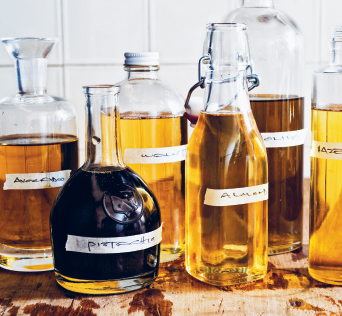OILING

Choosing Cooking Oils
Most cooks use too much oil when they sauté and sear food. A thin layer is all you need when using a seasoned pan (see here for how to season a pan). I use a maximum of 1 to 2 tablespoons of oil in a 10-inch sauté pan for searing and sautéing. If the ingredient has a lot of natural fat, like a good steak, or has been marinated in oil, you need even less. For porous ingredients like mushrooms and eggplant that absorb oil while cooking, add a dash if the pan becomes dry.
There are three factors to consider when choosing cooking oils: smoke point, resistance to oxidation, and taste. The first two affect the last, and every type of cooking oil has a different mix of these characteristics. When you heat cooking oil above its smoke point, it begins to burn and can impart an acrid flavor to the food, and it isn’t healthy to breathe or digest. Resistance to oxidation determines the stability of the oil and how it breaks down when exposed to heat, light, oxygen, and moisture. This is why oils should be stored in a cool place in dark-colored or opaque airtight containers. The slower the oil oxidizes, the longer it takes for it to turn rancid. Generally, the darker the oil, the more organic material it contains and the quicker it can go rancid.
Oils are extracted using different methods—some chemical, some mechanical. True cold expeller pressing is chemical-free and retains the most flavors and health benefits.
AVOCADO OR COCONUT OIL
These are the best choices for high-heat cooking like pan-frying and sautéing because of their high smoke points. Avocado oil can be slightly fruity, similar to olive oil, because it is pressed from the flesh of the avocado, not the seed. There are generally two types of avocado oil available—unrefined, sometimes called extra-virgin or virgin, and refined. Most of the refined avocado oil hasn’t been chemically processed; it’s just filtered more. I prefer it to coconut oil, another flavorful high-heat oil, because it’s not solid, but coconut oil is a good alternative. Both will improve your high-heat cooking because the temperature in the pan will get hotter before the oil starts to smoke. This also makes it great for pan frying. Because it doesn’t break down as easily, quickly straining and reusing it a few times it after frying will let you defray the cost.
OLIVE OIL
I reach for olive oil the most because of the flavor and body it adds to food. Its smoke point is lower than avocado or coconut, but still high enough to cook with. I use only extra-virgin olive oil and keep three varieties in my pantry: one to cook with; a richer, more flavorful one for vinaigrettes and cold sauces; and a high-quality, young extra-virgin oil with a lot of peppery flavor and vegetal notes to drizzle on dishes as a finishing oil. When olive oil is heated, it loses some of its health benefits and delicate flavor, so it’s not worth spending up for it when using it for high-heat cooking.
Fraud is rampant in the world of olive oils. Buy those that are extra-virgin, cold pressed, and organic to ensure there are no harmful chemicals used in the processing.
BUTTER
It’s not an oil, but it acts like one. If you melt high-quality butter, you’ll have a high-quality, flavorful cooking oil. I recommend using it instead of chemically processed vegetable and nut oils. For high-heat cooking, use clarified butter (also called ghee), from which the milk solids have been removed. Butter made from grass-fed, pastured cows is healthier and has a pleasantly sweet herbaceous flavor. Browned butter adds a rich, nutty element to any dish.
TREE NUT OILS
Your most flavorful options are walnut, almond, hazelnut, and pistachio. They have a low smoke point and a high cost, so don’t cook with these. Use them in vinaigrettes and cold sauces, or drizzle over soups and salads for a rich, nutty accent. French nut oils are the best, and their price reflects that. Nut oils are perishable, so check the pressing date and store in the fridge or a cool, dark place.
VEGETABLE OILS
Many conventional cooking oils you find at the supermarket are processed using harmful chemicals like hexane, and many are made from genetically modified crops. Vegetable oils undergo high-heat chemical-extraction processing, which causes them to go rancid. The oils are then deodorized with petroleum-based chemicals so that they don’t smell so bad—but they can be carcinogenic and leave an unpleasant taste behind. Choose expeller-pressed, non-GMO high-temperature vegetable and seed oils like canola and sunflower—they are slowly becoming more available and less expensive. They don’t add flavor, but they can withstand high heat. 
